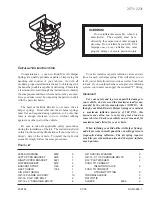
40
STARTING AND OPERATING
If You Stall Or Begin To Lose Headway
If you stall or begin to lose headway while
climbing a steep hill, allow your vehicle to come
to a stop and immediately apply the brake.
Restart the engine and shift into REVERSE.
Back slowly down the hill allowing engine
braking to control the descent and apply your
brakes, if necessary, but do not allow the tires
to lock.
Driving Through Water
Extreme care should be taken crossing any type
of water. Water crossings should be avoided, if
possible, and only be attempted when
necessary in a safe, responsible manner. Only
drive through areas which are designated and
approved. Tread lightly and avoid damage to the
environment. Know your vehicle's abilities and
be able to recover it if something goes wrong.
Never stop or shut a vehicle off when crossing
deep water unless you ingested water into the
engine air intake. If the engine stalls, do not
attempt to restart it. Determine if it has ingested
water first. The key to any crossing is low and
slow. Shift into DRIVE, with the transfer case in
the 4WD Low position and proceed very slowly
with a constant slow speed of (3 to 5 mph
[5 to 8 km/h] maximum) and light throttle. Keep
the vehicle moving; do not try to accelerate
through the crossing. After crossing any water
higher than the bottom of the axle differentials,
inspect all of the vehicle fluids for signs of water
ingestion.
WARNING!
If the engine stalls or you lose headway or
cannot make it to the top of a steep hill or
grade, never attempt to turn around. To do so
may result in tipping and rolling the vehicle,
which may result in severe injury. Always back
carefully straight down a hill in REVERSE.
Never back down a hill in NEUTRAL using only
the vehicle brakes. Never drive diagonally
across a hill, always drive straight up or down.
CAUTION!
Water ingestion into the axles, transmis
-
sion, transfer case, engine or vehicle inte
-
rior can occur if you drive too fast or
through too deep of water. Water can cause
permanent damage to engine, driveline or
other vehicle components, and your brakes
will be less effective once wet and/or
muddy.
When driving through water, do not exceed
5 mph (8 km/h). Always check water depth
before entering as a precaution, and check
all fluids afterward. Driving through water
may cause damage that may not be
covered by the New Vehicle Limited
Warranty.
21_DT_TRX_SU_EN_USC_t.book Page 40
















































